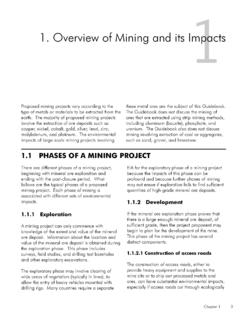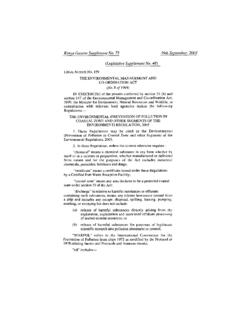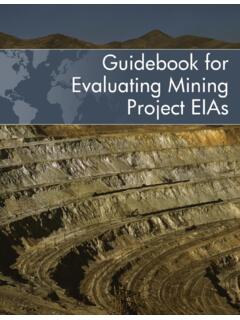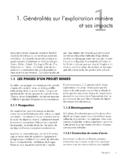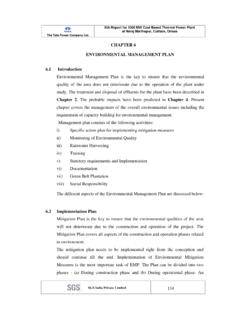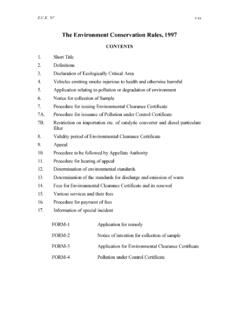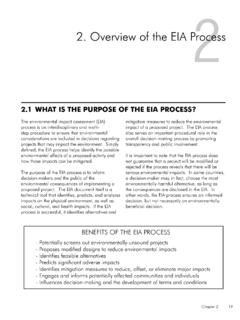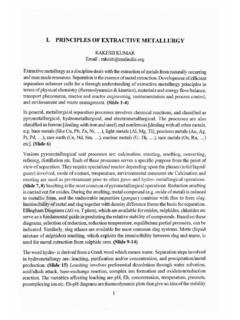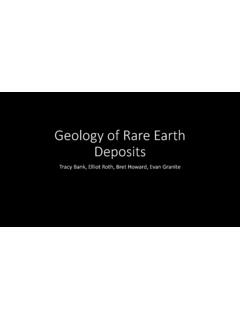Transcription of 1.1 PHASES OF A MINING PROJECT - Home | ELAW
1 Chapter 1 PHASES OF A MINING PROJECTT here are different PHASES of a MINING PROJECT , beginning with mineral ore exploration and ending with the post-closure period. What follows are the typical PHASES of a proposed MINING PROJECT . Each phase of MINING is associated with different sets of environmental ExplorationA MINING PROJECT can only commence with knowledge of the extent and value of the mineral ore deposit. Information about the location and value of the mineral ore deposit is obtained during the exploration phase. This phase includes surveys, field studies, and drilling test boreholes and other exploratory excavations.
2 The exploratory phase may involve clearing of wide areas of vegetation (typically in lines), to allow the entry of heavy vehicles mounted with drilling rigs. Many countries require a separate EIA for the exploratory phase of a MINING PROJECT because the impacts of this phase can be profound and because further PHASES of MINING may not ensue if exploration fails to find sufficient quantities of high-grade mineral ore DevelopmentIf the mineral ore exploration phase proves that there is a large enough mineral ore deposit, of sufficient grade, then the PROJECT proponent may begin to plan for the development of the mine. This phase of the MINING PROJECT has several distinct Construction of access roadsThe construction of access roads, either to provide heavy equipment and supplies to the mine site or to ship out processed metals and ores, can have substantial environmental impacts, especially if access roads cut through ecologically 11.
3 Overview of MINING and its ImpactsProposed MINING projects vary according to the type of metals or materials to be extracted from the earth. The majority of proposed MINING projects involve the extraction of ore deposits such as copper, nickel, cobalt, gold, silver, lead, zinc, molybdenum, and platinum. The environmental impacts of large-scale MINING projects involving these metal ores are the subject of this Guidebook. The Guidebook does not discuss the MINING of ores that are extracted using strip MINING methods, including aluminum (bauxite), phosphate, and uranium. The Guidebook also does not discuss MINING involving extraction of coal or aggregates, such as sand, gravel, and Guidebook for Evaluating MINING PROJECT EIAssensitive areas or are near previously isolated communities.
4 If a proposed MINING PROJECT involves the construction of any access roads, then the environmental impact assessment (EIA) for the PROJECT must include a comprehensive assessment of the environmental and social impacts of these roads. Site preparation and clearingIf a mine site is located in a remote, undeveloped area, the PROJECT proponent may need to begin by clearing land for the construction of staging areas that would house PROJECT personnel and equipment. Even before any land is mined, activities associated with site preparation and clearing can have significant environmental impacts, especially if they are within or adjacent to ecologically sensitive areas.
5 The EIA must assess, separately, the impacts associated with site preparation and Active miningOnce a MINING company has constructed access roads and prepared staging areas that would house PROJECT personnel and equipment, MINING may commence. All types of active MINING share a common aspect: the extraction and concentration (or beneficiation) of a metal from the earth. Proposed MINING projects differ considerably in the proposed method for extracting and concentrating the metallic almost every case, metallic ores are buried under a layer of ordinary soil or rock (called overburden or waste rock ) that must be moved or excavated to allow access to the ore deposit.
6 The first way in which proposed MINING projects differ is the proposed method of moving or excavating the overburden. What follows are brief descriptions of the most common Open-pit miningOpen-pit MINING is a type of strip MINING in which the ore deposit extends very deep in the ground, necessitating the removal of layer upon layer of overburden and ore. In many cases, logging of trees and clear-cutting or burning of vegetation above the ore deposit may precede removal of the overburden. The use of heavy machinery, usually bulldozers and dump trucks, is the most common means of removing overburden. Open-pit MINING often involves the removal of natively vegetated areas, and is therefore among the most environmentally-destructive types of MINING , especially within tropical open-pit MINING is employed for ore deposits at a substantial depth underground, it usually involves the creation of a pit that extends below the groundwater table.
7 In this case, groundwater must be pumped out of the pit to allow MINING to take place. A pit lake usually forms at some point in time after MINING stops and the groundwater pumps are turned near a MINING road, Pelambres mine, Chile PHOTO: Rocio Avila FernandezOpen-pit mine in Cerro de Pasco, PeruPHOTO: Centro de Cultura Popular LABOR, PeruChapter 1 Placer MINING Placer MINING is used when the metal of interest is associated with sediment in a stream bed or floodplain. Bulldozers, dredges, or hydraulic jets of water (a process called hydraulic MINING ) are used to extract the ore. Placer MINING is usually aimed at removing gold from stream sediments and floodplains.
8 Because placer MINING often occurs within a streambed, it is an environmentally-destructive type of MINING , releasing large quantities of sediment that can impact surface water for several miles downstream of the placer Underground miningIn underground MINING , a minimal amount of overburden is removed to gain access to the ore deposit. Access to this ore deposit is gained by tunnels or shafts. Tunnels or shafts lead to a more horizontal network of underground tunnels that directly access the ore. In an underground MINING method called stoping or block caving, sections or blocks of rock are removed in vertical strips that leave a connected underground cavity that is usually filled with cemented aggregate and waste underground MINING is a less environmentally-destructive means of gaining access to an ore deposit, it is often more costly and entails greater safety risks than strip MINING , including open-pit MINING .
9 While most large-scale MINING projects involve open-pit MINING , many large underground mines are in operation around the world. Reworking of inactive or abandoned mines and tailingsSome MINING projects involve the reworking of waste piles (often tailings) from inactive or abandoned mines, or older waste piles at active mines. Typically, this is proposed when more efficient methods of metal beneficiation have made it economical to re-extract metals from old MINING waste. The material from the piles may be sent to processing facilities on-site or off-site. MINING projects that only involve the reworking of abandoned mine waste piles avoid the environmental impacts of open-pit MINING and placer MINING , but still entail environmental impacts associated with purification (beneficiation) of metals from the waste Disposal of overburden and waste rock In almost every PROJECT , metallic ores are buried under a layer of ordinary soil or rock (called overburden or waste rock ) that must be moved or excavated to allow access to the metallic ore deposit.
10 For most MINING projects, the quantity of overburden generated by MINING is enormous. The ratio of the quantity of overburden to the quantity of mineral ore (called the strip ratio ) is usually greater than one, and can be much higher. For example, if a proposed MINING PROJECT involves the extraction of 100 million metric tons of mineral ore, then the proposed MINING PROJECT could generate more than one billion metric tons of overburden and waste rock. These high-volume wastes, sometimes containing significant levels of toxic substances, are usually deposited on-site, either in piles on the surface or as backfill in open pits, or within underground mines.

